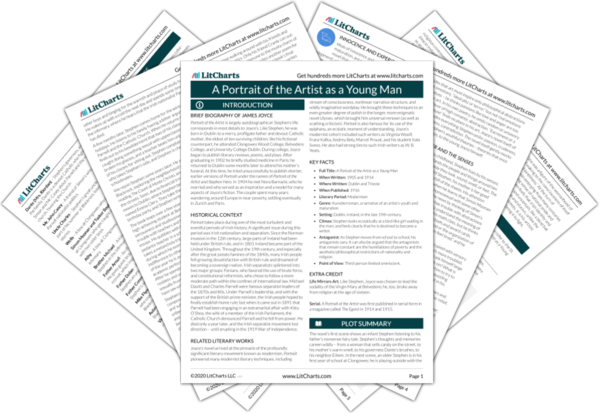Summary
Analysis
Father Arnall has come to give the students a guest lecture about the upcoming retreat. He tells them that the retreat is meant to take them away from the practical matters of daily life so that they can examine their souls and think deeply about religion. The subjects of his lectures will be death, judgment, hell, and heaven. He tells the boys that life on earth is meaningless compared to the afterlife – that nothing is more important than the salvation of the soul.
Father Arnall emphasizes above all that the boys will be expected to focus on their souls by absorbing ancient religious teachings. If we consider Stephen’s feeling that the soul is private and ghostly, separate from communal, external influences, Father Arnall’s announcement seems paradoxical.
Themes
Quiz
Test Yourself
After the lecture, Stephen walks home and eats dinner. The grease on his lips makes him feel like a dirty animal, and he is filled with a confused fear. The following day’s lecture on death affects Stephen profoundly: he imagines his own death with terrifying clarity, and he imagines god sending his soul to hell. He imagines the end of the world and the day of judgment, when the sinners repent too late of their sins and are banished from the kingdom of heaven. Father Arnall tells the students that righteous people think of death all the time, but do not fear it.
Stephen is deeply moved by the lecture because Father Arnall is a skilled, evocative speaker. He describes death precisely in order to make the boys imagine it, to experience it secondhand. The irony is quite pointed: Stephen feels sincere religious devotion only via his senses, which religion generally seeks to quell.
Themes
Literary Devices
Quiz
Test Yourself
Stephen feels as though the speech is addressed to him directly; he thinks that the words are rousing his soul from its dirt. On his way home, a girl’s laughter makes him ashamed of his lustful thoughts, which have soiled the memory of E____ C____. He remembers the details of his his sins with disgust. Salvation seems impossible, but he imagines standing with E____ C____ in front of the Virgin Mary, who forgives them.
Father Arnall’s lecture fills Stephen with shame and self-disgust, but also makes him feel that his soul is a separate and separable entity from his body that is capable of purity. The lecture also seems to confirm Stephen’s feeling that his lust is absolutely different from his unfulfilled romantic feelings for E____ C____ .
Themes
Quiz
Test Yourself
It is raining when Stephen walks to the chapel the following day, and he imagines that the great flood has come again to drown the world. Father Arnall talks that day about the fallen angel Lucifer, the temptation of Eve, and Christ’s redemption of man’s sins. He goes on to describe hell in minute sensory detail: the darkness, the stench, the heat, the swears and screams. Every one of the five senses is in great pain. All earthly laws are overturned, and sinners are forced to exist in the company of devils.
Stephen seems to be experiencing something akin to a nervous breakdown. The fire-and-brimstone lectures have distorted his perceptions so that he sees doom everywhere he looks. Father Arnall’s lecture is once again focused on shocking and stimulating the senses. Stephen’s bout of religious piety is similar to a case of hypnosis.
Themes
Quiz
Test Yourself
Get the entire Portrait of the Artist LitChart as a printable PDF.

Stephen walks out of the chapel profoundly shaken. He feels as though he has already died and gone to hell; he can almost feel the heat and pain. The sounds of his friends’ voices remind him that he is not really dead yet – that he still has time to save his soul. He resolves to confess to a priest, but not at the school chapel.
At this point, Stephen seems to have yielded entirely to his religious terror: his thoughts and actions seem less deliberate and willful than they are ordinarily. He is not entirely in control of himself.
Themes
Quiz
Test Yourself
In the next sermon, later that evening, Father Arnall describes hell’s spiritual torments. Sin, he says, turns sinners away from their higher natures and towards their animal natures. In hell, the most intense spiritual suffering is the pain of losing god; the second sort of suffering is the pain of a guilty conscience; the third is the pain of intensity; and the fourth is the pain of eternity. These are impossible to imagine, but the Father does his best to make it all as vivid as possible. Finally, the boys recite the words of contrition, indicating that they’ve repented of their sins.
Father Arnall clearly articulates the identity structure that underpins the lectures: the soul tends to good, the body tends to evil, so human nature is deeply divided. In hell, spiritual suffering is the absence of god and the presence of emptiness (infinity and eternity): in a way, hell is the pain of eternally losing one’s soul. The soul is profoundly important to Stephen, so the threat of its loss works very powerfully on him.
Themes
Quiz
Test Yourself












